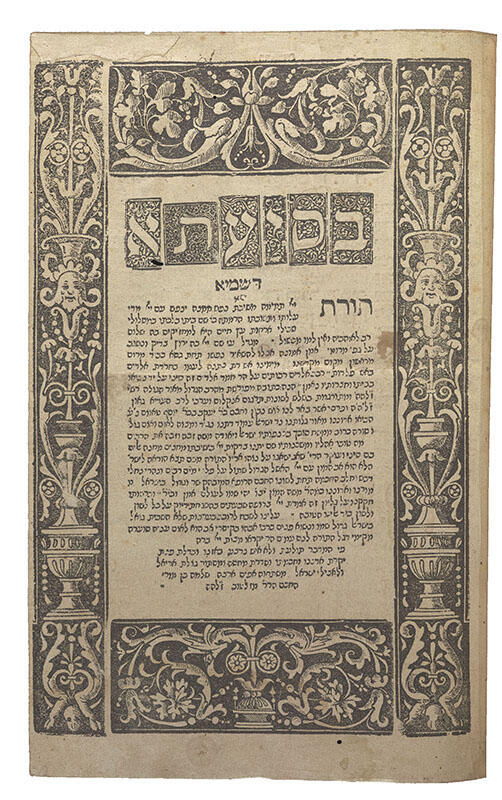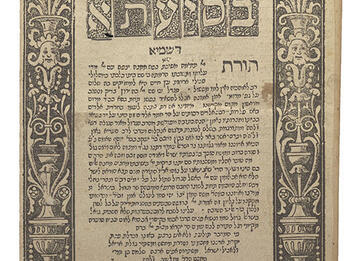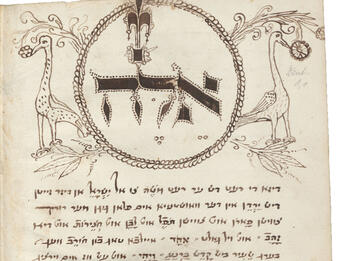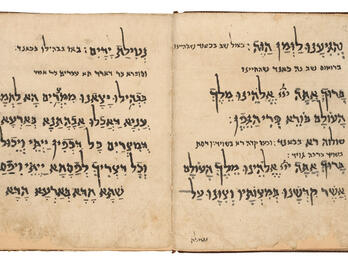Compendia de las sheḥitot (Compendium of the Laws of Kosher Slaughtering)
This is a short compendium of the sheḥitot [rules for kosher slaughter] taken from Rabbenu Moshe [Maimonides] and Rabbenu Ya‘akob [Jacob ben Asher], without any errors about what is required, and with glosses provided where necessary. It is organized so that someone who does not know these rules or does not understand the holy language can understand them perfectly and effortlessly on his own, thanks to this compendium, and can retain them in memory after studying them well. It will also help those who have forgotten them to memorize them easily. Here is the structure of this compendium: it is grouped logically into five major sections, referred to as chapters because they are headings above the treatises.1 Each chapter heading lists its subsections, which are the treatises in that chapter, and the purpose of the heading is to clearly specify those parts.
Chapter One, regarding the things that must be slaughtered by slitting their throat before they may be eaten, contains three treatises:
- Three types of animals that must be slaughtered in this way before eating.
- Three others that may be eaten without this kind of slaughter.
- Time restrictions on when an animal may be slaughtered.
The animals that must be slaughtered by cutting their throat are clean domestic animals—goats and sheep; clean wild animals—fallow deer, roe deer, and so on—and all clean birds.
The three that do not need to be slaughtered in this manner are fish and locusts and any unborn offspring found inside a slaughtered animal, unless this unborn put its feet on the ground while alive and was enough days old that it will need to be slaughtered as if it had been born.
Note that if this unborn offspring, while inside the living mother, poked out any limb, that limb is asur [forbidden], and even if it later withdrew the limb back inside and the mother was then slaughtered, the slaughtering of the mother does not count for that limb. However, the rest that did not poke out is kosher with the sheḥita of the mother, unless it stuck out its head or most of the body together or in parts, in which case all that did not come out is also forbidden unless it was alive and old enough to be slaughtered.
There are three time restrictions:
- Male or female goats or sheep that cannot be slaughtered because it is not permissible to slaughter parent and child on the same day, and if such slaughter does occur, then the meat of the second, which was slaughtered with isur [prohibition], is forbidden on that day.
- For any domestic or wild beast, sheḥita is not valid until seven whole days after its birth.
- A chicken is called a serpent until it opens its eyes, and any slaughter before then is invalid.
Chapter Two, regarding those who will be authorized to slaughter for food. The following eight requirements must be met: law, mind, knowledge, experience, healthy senses, modesty, clean thoughts, and slaughtering vigorously even when not concentrating.
1. Anyone who is to slaughter for food must be a known and reputable Jew, and even if he is considered a sinner who is not strict about certain commandments, he will not be deemed suspect for purposes of slaughtering except in one of three cases: if he worships any other than the God of Israel, if he breaks the Sabbath in public, or if he eats forbidden meat even though kosher meat is available, then, even if we saw him perform a slaughter correctly, his slaughtering is forbidden as if it did not conform to the law. However, if he eats nevelah [a carcass of an otherwise kosher animal that did not die by kosher slaughter] eagerly because he cannot find kosher meat, he too may slaughter. As long as the other conditions are met, giving him an inspected knife, or if he slaughtered with his own knife and we examined it afterward and it was found to be good, then the meat is kosher because we do not reclassify something from permitted to forbidden until evidence is found to cast it out of that category.
2. The mind: He must not be a madman, deaf, a child, or drunk. Here, “madman” means one who does any of these three things in madness: tears his clothes, squanders his money, or goes to sleep in cemeteries or similar places. “Deaf” in this context means one who neither hears nor speaks. “Child” means one who does not know how to control his hands skillfully to perform slaughter. “Drunk” describes one who has reached the level of the drunkenness of Lot. These must not be authorized to slaughter, not even in order to feed dogs. And if it happens that they did slaughter and any of the kesherim [certified inspectors] saw that they slaughtered correctly, it is kosher.
3. Knowledge: If questioned about the laws of she-ḥita, he can answer all questions correctly, indicating that what is forbidden is forbidden and what is permitted is permitted.
4. Experience: He must have slaughtered correctly in front of the kesherim two or three times without fainting. Note that those who are disqualified for lack of knowledge or experience may slaughter under the supervision of one or more kesherim. Note, too, that testimony of someone disqualified for lack of experience is sufficient if he says he slaughtered correctly without fainting, but this is not the case for one disqualified for lack of knowledge, for he cannot testify about things he does not know, and his experience cannot be known reliably without a written document.
5. The senses: He cannot be blind, for he must work with precision, or deaf, for he must hear the blessing he will say.
6. Modesty: He must have his shame2 covered so that he may say a blessing. Note that those disqualified [before the fact] for being blind or deaf or naked, if they did slaughter, even if they were alone, it is considered kosher [after the fact].
7. Thought: One who slaughters for the sake of avodah zarah [idolatry] or for the sake of a korban [sacrificial offering], even if it is in the name of our Lord, the sheḥita is forbidden. Note that if he slaughtered in the name of something that can be held in the hands, even if not to worship it but to misuse it in some other superstitious way, then the meat is forbidden and neither he nor anyone else can receive benefit from it. And if he slaughtered for the sake of some fixed thing, such as all the heavenly bodies or for a mountain or river or some other thing joined to the earth, but if the purpose of the slaughter was not to worship the thing or to ask for health or for some other superstitious misuse, then the meat is forbidden for purposes of food but can be sold. Also, one who slaughters for the sake of a sacrificial offering—for the types of offerings that are voluntary, such as a burnt-offering, peace offering, thanksgiving offering, or Passover offering—that slaughter is forbidden. And if he slaughtered for the sake of a ḥatat [sin offering] or asham [guilt offering], which are types of sacrifices performed out of obligation, if he did not have such an obligation at the time of the slaughter, it is kosher.
8. Vigor: The force used in the slaughter must be human force, even if not intentional. So if someone threw a knife at a wall and as it passed through the air it performed a proper slaughter, it is kosher. Also if a slaughter occurred under indirect human power it is kosher. For example, if he were turning a wheel that had a knife attached to it, it is kosher. However, if the wheel is turned by water, then it depends. If he released the water and then the slaughter occurred on the first turn of the wheel, that counts as human force and is kosher, and if the slaughter was produced by subsequent turns of the wheel, it is forbidden.
Chapter Three, regarding the slaughtering knife and the seven aspects of it that must be considered: body, cut, size, quality, whose knife it is, lack of prohibition, and inspection before and after slaughter.
1. The slaughtering knife may be anything that cuts—metal or wood or stone—that has been pulled out. If it has always been connected to the ground or was put into the ground permanently, the meat is forbidden. However, if slaughter was performed using something that was put into the ground only temporarily, it is kosher. If slaughter occurred using an animal’s tooth still in the animal then the meat is forbidden, but slaughtering with a jaw that has a single tooth attached to it is kosher.
2. The cut: As long as there is no nick in the blade, it may be used for slaughter even if it is dull. There are three types of nicks in blades: One is where the nick snags a fingernail being run up and down it, in which case slaughters performed with it are nevelah. Another is a nick that can be felt only when feeling along the blade in one direction. If the slaughter was performed in a single stroke in the direction opposite the one where the nick is felt, it is kosher [after the fact] even though the use [of a knife in that condition] is not authorized. Another is when the knife has a hole in it and does not snag in the same way that the knife with the nick did, and when sharpening it removed any roughness but there remained a hole in the middle, this knife is authorized for use in slaughtering at any time. A knife that is partly serrated or has a nick anywhere on the blade shall not be used for slaughter. And if it happens that he slaughtered with it and knows that he slaughtered with the good edge, it is kosher. And on a holy festival he is authorized to slaughter with it by first tying something over the nick.
3. Size: If the knife has a flat-nosed end and if slaughter is performed in two strokes, then even if the knife is very short, it is kosher. If it is performed in a single stroke, the knife’s length must be twice the width of the throats to be cut. This also applies if it has a pointed end.
4. Quality: If the slaughter was performed with a blade red-hot from fire, the meat is forbidden.
5. Whose knife it is: A knife intended for avodah zarah, clean of prohibition, is authorized for slaughtering a healthy animal because slaughtering it reduces its value, but not a sick animal, because slaughtering it increases its value. The slaughter [of a healthy animal with such a knife] is kosher because the profit [from selling its meat] is very minor compared to what it could cost to rent another animal.3
6. Lack of prohibition: If slaughter is performed with a knife belonging to a gentile, which is known to have been used by the gentile in the previous twenty-four hours, it will be necessary to cut away the flesh at the sheḥita site [the part of the neck where the cut was made]. A knife previously used for kosher slaughter may be used for slaughter even if it is dirty with blood. However, if it was used to cut nevelah or terefah, the knife must be washed or must be thrust into hard earth ten times in order to slaughter with it afterward.
7. Inspection of the knife: It is necessary to inspect the knife before and after. If it was inspected first and not afterward because it was lost or was used to break something hard after slaughtering and then it was inspected and found to be nicked, we will assume the knife was good at the time of slaughter since it was inspected beforehand, and the meat is kosher, but if it was not inspected before and was used in slaughter, it is deemed nicked and the meat is forbidden unless the knife is inspected afterward and found to be good. If many animals were slaughtered together without checking the knife between one and the next, and if it was inspected afterward and found to be nicked, they are all forbidden, even the first animal, since it might have been nicked on the skin of the first one. The method for inspecting the knife is to draw its cutting edge and both sides back and forth over one’s fingernail, which means a total of six passes back and forth, and as many times again on the flesh of the finger, for a total of twelve passes.
Chapter Four, regarding things related to the work and performance of sheḥita. There are seven treatises: What part of the animal to cut and how much, how to perform the slaughter, the five things that disqualify a sheḥita, six lesions, checking the cuts on the windpipe and gullet afterward, covering the blood after checking the cuts, and inspecting the knife.
Notes
[The word chapter comes from a Latin word for “head.”—Trans.]
[A euphemism for “nakedness.” Often a specific reference to genitalia.—Trans.]
[The principle here is that Jews should not profit from using a knife intended for idolatrous rituals. The distinction here is that a sick animal may be worth more dead (as meat) than alive. Slaughtering a healthy animal with such a knife is therefore allowed because it results in a net loss rather than a profit.—Trans.]
Credits
Author Unknown, “Compendia de las sheḥitot (Compendium of the Laws of Kosher Slaughtering)” (Manuscript, Constantinople, ca. 1510). Published in: Dov Cohen and Ora Schwarzwald, “Compendio Delas Šeḥitot (Constantinople ca. 1510): The First Judeo-Spanish Printed Publication,” Journal of Jewish Languages, 2019, 27–52: 46–51.
Published in: The Posen Library of Jewish Culture and Civilization, vol. 5.







